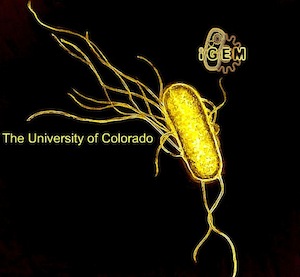Team:CU-Boulder
From 2012.igem.org

Welcome to the CU-iGEM 2012 wiki! This is the first time the University of Colorado has competed in the International Genetically Engineered Machines competition, and we are excited to show you the science coming out of Boulder, Colorado! We are a team of five undergraduates advised by our two graduate mentors, and a smattering of post-docs. This year is also the grand opening of the brand new Biofrontiers building for bioscience, and biotechnology research. We have been fortunate enough to have lab space in the new building.
|
Bacterial Nightlight  Certain organisms use bioluminescence for communication, mating, or intimidating predators. Our project aims to harness the bioluminescence genes, known as the Lux operon, from Aliivibrio fischeri, to make a genetically engineered E. Coli machine. The six genes of the 9-kilobase Lux operon, LuxCDABE and G, are regulated by LuxI and LuxR and produce blue-green light through the following reaction: FMNH2+O2+R-CHO → FMN + R-COOH + H2O + Light Instead of simply transforming an E.Coli with the Lux operon under a single promoter, we have isolated each of the six genes independently and placed them under different promoters to optimize the system and produce the maximum amount of light. The entire system is regulated by a light-repressed promoter so the bacteria only luminesce during nighttime. In conclusion, we have created the first ever bacteria night light! Possible real world applications for this are endless and include illuminating street signs, marking hiking trails, and even giving light to impoverished areas of the world that do not have access to electricity. |
No More Biofilm!  This year the CU iGEM team has harnessed the quorum sensing factors endogenous in the Salmonella enterica serovar typhimurium LT2 strain to detect AHLs produced by other bacteria. Neither Salmonella nor E. coli have been shown to produce detectable levels of AHLs, so they were model organisms for the detection of other AHL producing bacteria such as ……. AHLs are small molecules synthesized by most gram negative bacteria, and are able to freely diffuse throughout the membrane. When the concentration of AHL producing bacteria in a specific area increases, the total concentration of AHLs diffusing into the cytoplasm also increases. Once a threshold level of AHLs are in the cytosol, transcription factors like the Vibrio fisheri LuxR or Salmonella enterica SdiA activate gene synthesis for pathogenesis factors to be produced. The SdiA transcription factor has been shown to be more sensitive to lower concentrations and a greater diversity of AHLs than its LuxR homolog. |
| You can write a background of your team here. Give us a background of your team, the members, etc. Or tell us more about something of your choosing. | |
|
Tell us more about your project. Give us background. Use this as the abstract of your project. Be descriptive but concise (1-2 paragraphs) | |
| Team CU-Boulder |
| Official Team Profile |
|---|
</html>
 "
"







 1
1 2
2 3
3 4
4 5
5 6
6

